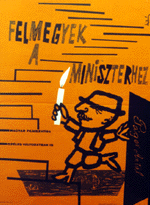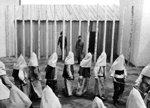
Frigyes Bán :
I'll Appeal to the Minister
(1961)
107 KByte
At the turn of the 1950s and the 1960s, colourful and attractive film posters reveal the following inscription: Also in a broad version! - The terminology is unusual for the modern-day viewer. Is it a broad version or a film on a broad screen? Aren't the two the same? Posters advertise Alba Regia, Do Not Keep Off the Grass, The Brute, Csutak and the Grey Horse, I'll Appeal to the Minister, or A Rainy Sunday in broad versions. Could it be that these films had a normal as well as a broad version already then? Why then is the terminology different on the posters?
Hungarian films of the era, enjoying unquestioned popularity, certainly made the impression of having been produced in a broad screen format. In reality, however, these films were of normal proportion, as new technology - in the absence of financial means - did not proliferate in Hungary. Inventive directors of photography, however, attempted to make up for the visual experience provided by broad screen films. Photographs were made in the traditional 1:1,38 side proportion, while the director of photography had to compose the pictures in a way which resulted in essential parts of individual visual elements being exactly along the strictly defined middle range. Thus, during screening, by way of a mask placed at the frame gate, the lower and higher - and usually less important parts - of the picture could be covered up. If this film - covered up above as well as below - is screened with an objective of greater enlarging force, the result will be a substantially broader picture with retained height. During the years, a number of coverage standards of different proportions have been developed over the world. In Europe, and therefore in Hungary, the 1:1,66 system spread, while overseas the popular version was the 1:1,85 proportion. Accordingly, Hungarian cinemas were obliged to develop both coverage systems. In time, every film that was broader than the norm came to be called a "linco", i.e. lincoscope in professional jargon. Only elderly film professionals remember today how this specifically Hungarian term of film was born and what it actually meant.
It was the French professor Chretien who first presented a truly broad screen system film at the Paris World Exhibition in 1937. The term "Cinema Scope" comes from the American Fox Company, but similar solutions are covered by the word Superscope - developed by Paramount - or the words Francscope or Agascope used primarily in Europe.
The main element of the system is the anamorph optics bordered with a special cylinderised surface containing lenses. Its lessening effect is different in the vertical and the horizontal layers, in a usual proportion of 2:1. The light sound Cinema Scope system produces an image field of 1: 2,35 on the traditional normal light film in a way which changes the horizontal-vertical proportion of takes while shooting, i.e. narrowing it in the horizontal layer. This results in an effect which seemingly lengthens figures. The screening optics in its turn produces a distortion in the opposite direction with a similar set of lenses, pulling the picture apart and restoring the characters' original proportions.
Our first truly broad-screen, i.e. Cinemascope, film itself symbolises a milestone. Zoltán Várkonyi's monumental adaptation of Mór Jókai's The Man with the Golden Touch was made in 1962. This was followed by a series of large historical tableaux, made of similarly classical literary works of art, e.g. Men and Banners I-II (1965), The Last Nabobs and The Last Nabobs -Zoltán Kárpáthy (1966), as well as The Lost Talisman I-II (1968). But many of contemporary historical films revisiting previously unquestionable historical legends were also made in the Cinemascope format, e.g. Miklós Jancsó: The Round-Up (1965), Ferenc Kósa: Ten Thousand Suns (1965), Miklós Jancsó: The Red and the White (1967), The Confrontation (1968), etc.
The Cinemascope shooting optics is rather expensive. Never did the Hungarian film industry own one on its own, borrowing it from abroad for the shooting time. Towards the beginning of the '70s, fewer and fewer Cinemascope films were made in Hungary, while both coverage methods became customary in production. When a production is launched, the director and the director of photography decide which screening technique to use. Frame borders are defined accordingly in the camera's searcher. In the modern day, the application of the coverage technique became an outright fashion. To mention only a few, the following films were made with the 1:1,66 system in the recent years; Blue Danube Waltz, Bitches, Escape, Feri's Gang, The Witness Again.

Ferenc Kósa :
Ten Thousand Suns(1965)
62 KByte

Miklós Jancsó :
The Round- Up (1965)
62 KByte

